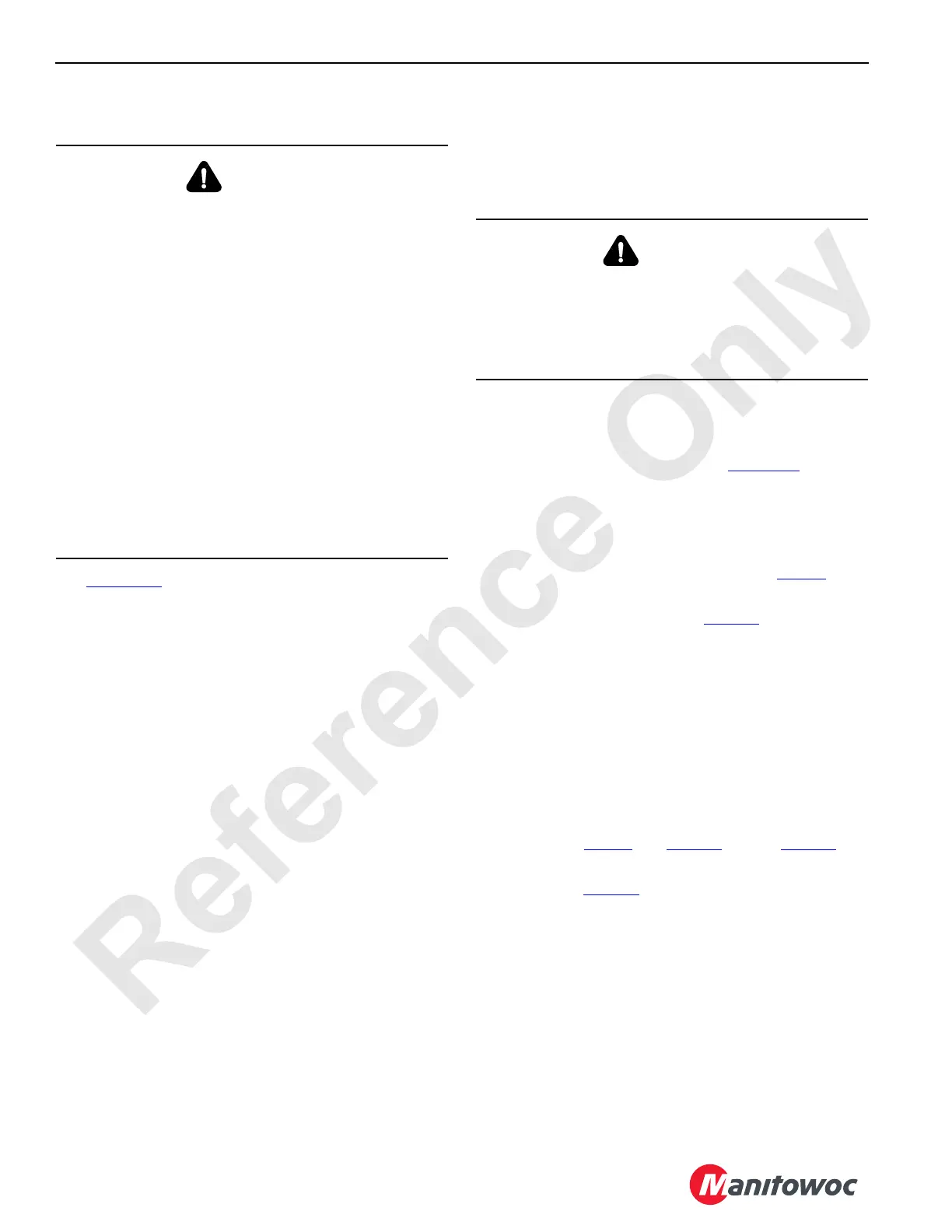HOISTS 2250 SERVICE/MAINTENANCE MANUAL
5-22
Published 07-19-16, Control # 249-01
Inspection and Adjustment
See Figure 5-17 for the following procedure.
NOTE: Make sure the air system pressure is 8,3 to 9,1 bar
(120 to 132 psi) at all times during the inspection
and adjustment procedure.
1. Lower the load block or weight ball to the ground. Pay
out enough wire rope so the drums can be operated
without hoisting the load block or weight ball.
2. Select the right rear drum if not already done.
3. Note the air pressure indicated on the pressure gauge in
the right rear console and turn off the pressure regulator.
4. Select Standard mode and confirm.
5. Remove the cover over the access hole (5) at the clutch.
6. Position the right rear drum clutch parts in the access
hole for inspection and adjust as follows.
a. Stand clear of the clutch while the right rear drum is
turning.
b. Move the rear drum handle in either direction from
the OFF position to turn the clutch and drum.
c. When the desired part is accessible through the
access hole, signal the operator to release the drum
handle to the OFF position to stop the clutch and
drum.
7. Position the live end (2) of the clutch band (11) in the
access hole and inspect the lining (10) wear.
The clutch lining is 10 mm (3/8 in) thick when new.
Replace the lining before its thickness is less than 6 mm
(1/4 in), or the drum will be scored by the lining rivets.
8. Inspect all pins and linkage for excessive wear and
replace parts as required. Excessively worn pins and
linkage make it difficult to properly adjust the clutches.
9. Lubricate the clutch linkage. See Lubrication
Section 9
for more information.
10. Rotate the rear drum clutch so the cylinder rod is in the
access hole.
If Mark A is flush with the end of the air cylinder (8), no
further adjustment is required. Proceed to step 12
.
11. If Mark A is not flush with the end of the cylinder,
continue with the procedure at step 11
a.
a. Rotate the rear drum clutch so the adjusting nut (3)
and jam nut (4) are in the access hole.
b. Loosen the jam nut several turns.
c. Release the rear drum clutch—pull the front drum
handle back until the front drum just starts to turn
and stop (this releases the rear drum clutch).
d. Tighten the adjusting nut as required. Turning the
adjusting nut one flat moves the cylinder rod and
Mark A approximately 14 mm (9/16 in).
e. Repeat step 10
and step 11a through step 11d until
Mark A is flush with the end of the cylinder.
f. Repeat step 11
a and securely tighten the jam nut to
lock the adjustment.
12. Adjust each band guide (13) as follows.
a. Rotate the rear drum clutch so the band guide is in
the access hole.
b. With the rear drum clutch applied, check the
clearance between the band guide and clutch band
with a feeler gauge. Clearance should be 1 mm (1/
32 in).
CAUTION
Moving Machinery Hazard!
It is necessary to rotate the load drum and apply/release
the drum clutch during inspection, adjustment, and
overhaul steps. This creates a condition in which, if care is
not exercised, minor injury or equipment damage may
occur.
Drum clutch inspection, adjustment, and overhaul require
two people—one to operate the drum controls and one to
perform inspection, adjustment, and overhaul steps.
Maintain constant communication between the adjuster
and operator so the drum is not operated while the
adjuster is in contact with parts.
• The adjuster shall stay clear of all moving parts while
the load drum and clutch are being operated.
• The operator shall not operate drum controls until the
adjuster is clear of moving parts.
Lower the load block or weight ball onto the ground so the
wire rope is slack on the drum being serviced.
WARNING
Falling Load Hazard!
Aftermarket clutch linings may not provide the proper
clutch torque. The clutch could slip, allowing the load to
drop, resulting in death or serious injury.
Only use Manitowoc Cranes original equipment linings.
